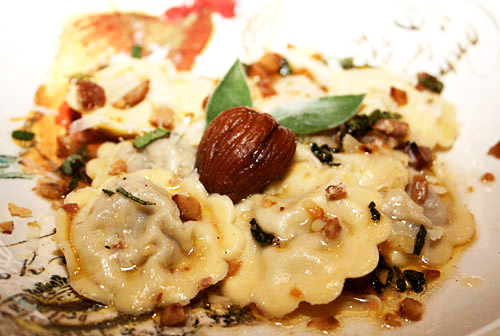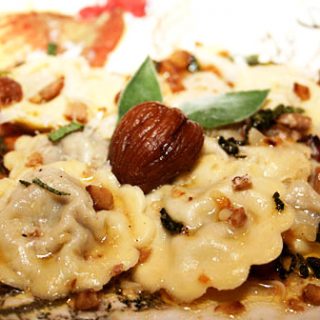Chestnut Ravioli With Brown Butter Sage Sauce

On our last trip to Italy I was amazed to see produce stands selling fresh chestnuts at every street market we came across and I vowed that as soon as I returned home and could get into my own kitchen, I would work on a few recipes using these delicious morsels. This recipe was one that evolved from my original plant, but turned out exactly as I had hoped.
I toasted the chestnuts in the oven, then peeled and chopped them. You could however simply use chestnuts from a can or jar which would eliminate that step for you. I combined the chopped chestnuts with some pancetta, onions and a little apple to create a very delicious seasonal stuffing for ravioli.
If you cannot find pancetta, bacon will work as well. Because the flavor of the filling was a bit delicate I decided that the only sauce needed was a drizzle of browned butter flavored with fresh sage. I garnished my ravioli with some extra chopped toasted chestnuts that I had left over to enhance the flavor and add a little texture.
Buon Appetito!
Deborah Mele

Chestnut Ravioli With Brown Butter Sage Sauce
A unique stuffed pasta that is a great way to celebrate fall.
Ingredients
Filling:
- 1/2 Pound Shelled Chestnuts, Roasted And Shells Removed, Or 1 Cup Chestnuts From A Jar
- 2 Ounces Sliced Pancetta, Finely Chopped
- 1/4 Cup Finely Chopped Onion
- 2 Tablespoons Unsalted Butter
- 1/3 Cup Water
- 1/2 Cup Finely Chopped Peeled Apple
- 3 Tablespoons Finely Chopped Fresh Parsley
- Black Pepper
Dough:
- 2 Cups All-Purpose Flour
- 3 Eggs
- 1/2 Teaspoon Salt
- 2 Tablespoons Olive Oil
Sauce:
- 6 Tablespoons Butter
- 6 Fresh sage Leaves, Coarsely Chopped
To Serve:
- Freshly Grated Parmesan Cheese
Instructions
- Combine the flour and salt on a flat work surface; shape into a mound and make a well in the center.
- Add the eggs and 1 tablespoon of the olive oil to the well and lightly beat with a fork.
- Gradually draw in the flour from the inside wall of the well in a circular motion.
- Continue to incorporate all the flour until it forms a ball, then wrap the ball in plastic wrap and let rest 30 minutes.
- While the pasta is resting, prepare the filling.
- Cook the pancetta in the two tablespoons of butter until lightly browned, then add the onion and cook until it is translucent and soft.
- Add the chestnuts and water and cook until the chestnuts have softened and the water is almost completely absorbed.
- Transfer to a bowl and season with black pepper.
- Add the chopped apple and parsley and mix well.
- Cut the ball of dough in 1/2, cover and cover the piece you are not immediately using to prevent it from drying out.
- Dust the counter and dough with a little flour.
- Press the dough into a rectangle and roll it through a pasta machine, 2 or 3 times, at widest setting.
- Pull and stretch the sheet of dough with the palm of your hand as it emerges from the rollers.
- Reduce the setting and crank the dough through again, 2 or 3 times.
- Continue tightening until the machine is at the second narrowest setting; the dough should be almost paper-thin.
- If cutting the ravioli by hand, dust the counter and sheet of dough with flour, lay out the long sheet of pasta, and brush the top surface with a little water, which acts as a glue.
- Drop 1 tablespoon of the filling on 1/2 of the pasta sheet, about 2-inches apart.
- Fold the other 1/2 over the filling like a blanket, then with your fingers, gently press out air pockets around each mound of filling.
- Use a sharp knife to cut each pillow into squares and crimp the 4 edges with the tins of a fork to make a tight seal. (A fluted pastry wheel also works well to make an attractive edge around the pasta.)
- Dust the ravioli and a sheet pan with cornmeal to prevent the pasta from sticking and lay them out to dry slightly while assembling the rest.
- If not using within an hour or two refrigerate until needed.
- If using a ravioli form, lay one sheet of pasta over the form and press with the plate it comes with to create indentations.
- Spoon a teaspoonful of filling into each indentation and brush the edges with water.
- Lay another sheet of pasta on top and using your fingers press out excess air pockets.
- Use a rolling pin to press the two layers of dough together and cut the ravioli.
- Place on a baking sheet dusted with a little flour or cornmeal.
- To make the sauce, heat the butter in a small saucepan over moderate heat until it begins to brown, add the sage and mix.
- Season with salt and pepper and keep warm.
- Cook the ravioli in a large pot of salted boiling water until tender, about 4 to 5 minutes.
- Drain, and divide into individual heated pasta bowls.
- Drizzle the pasta with the browned butter and sage and serve immediately offering grated parmesan cheese at the table.